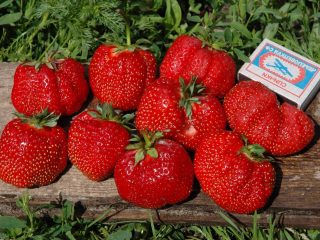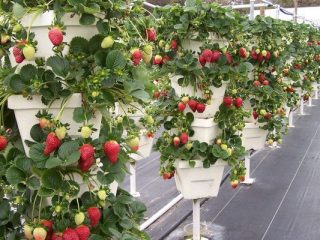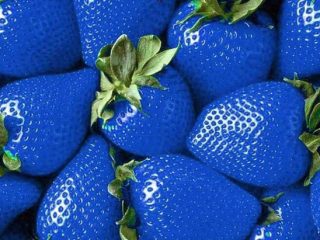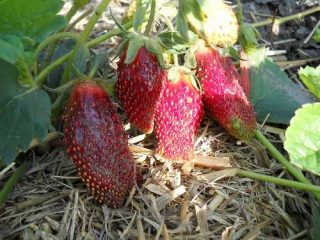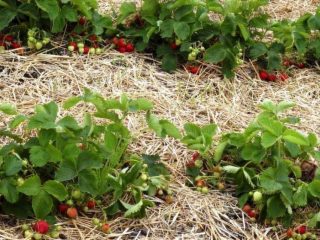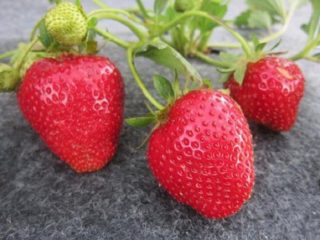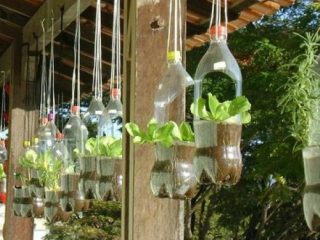Content
Strawberry Charlotte is a French variety that produces 4-5 crops per season. The crop is resistant to lack of lighting, so it bears fruit all year round in heated greenhouses. The yield is low (up to 1 kg per bush), but the berries are very sweet and juicy, with a rich aroma and a pleasant aftertaste.
History of selection
Charlotte is a strawberry variety bred in France in 1995. Obtained by crossing the Cal.19 variety and the famous Mara de Bois variety, which is distributed in many countries. The originator of the Charlotte variety is CIREF.
Strawberries came to Russia 10 years later - in 2004. They spread to different regions and were liked by many gardeners for their pleasant taste. The crop is not included in the register of selection achievements. However, many summer residents continue to grow it on private farms.
Description of strawberry variety Charlotte and characteristics
Strawberry Charlotte produces small, moderately spreading, medium-leafed bushes. They are compact and do not take up much space. The leaves are large, typical green in color, darker towards the top. The surface is slightly wrinkled. Peduncles are slightly higher than the leaves, bending under the weight of the berries. There are few whiskers, which makes it easier to care for.
Characteristics of fruits, taste
Charlotte strawberry fruits have a symmetrical round-conical shape. The sizes are medium and large (weight 15–20 g), mostly uniform, not too different from each other. The color is bright red, with a pleasant shine. The achenes are located on the surface.
The pulp of Charlotte strawberries is very juicy and aromatic, the consistency is medium - more delicate than that of Alba and San Andreas, but denser compared to the Miracle of the World variety.
The taste is pleasant, very sweet, with a rich aftertaste. The aroma is reminiscent of classic wild strawberries. The taste contains nutmeg and fruit notes. These berries will appeal to connoisseurs of truly sweet strawberries.
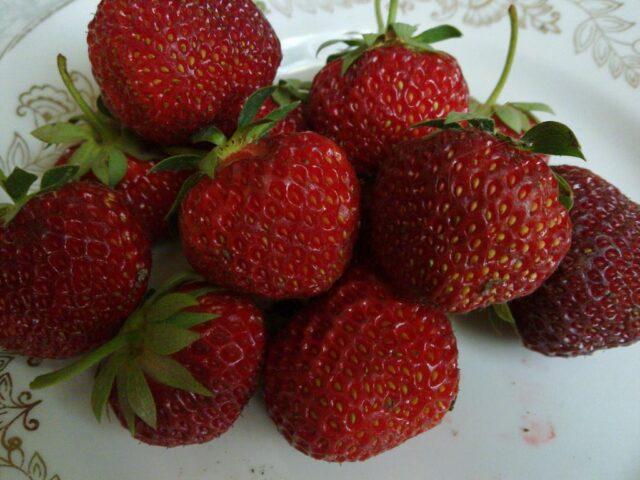
Charlotte is a classic dessert option: the fruits are consumed fresh
Ripening time, yield and keeping quality
If cultivated in open beds, the crop bears fruit until the first frost, i.e. until September inclusive. At the same time, fruiting begins in June - the variety is early. Strawberry Charlotte is a remontant variety; it can produce crops all year round (when grown in a heated greenhouse). Productivity is moderate - from 500 g to 1 kg per bush. The indicator greatly depends on the weather and the characteristics of care.
Despite the fact that the skin of the fruit is quite dense, they are not intended for long-term storage in the refrigerator. Transportability is also low.But if the berries are collected at the stage of technical ripeness, they can be transported over long distances.
Growing regions, frost resistance
Charlotte strawberries are quite picky about temperature, and they grow normally even with a lot of cloudy days. The frost resistance of the variety is satisfactory, although resistance to drought is low. Therefore, during the dry period, watering is required at least twice a week.
The culture can be grown in various areas of the country. But in regions with short summers (Ural, Siberia) it is preferable to grow in greenhouses. This will allow you to get a stable yield of up to 1 kg per plant.
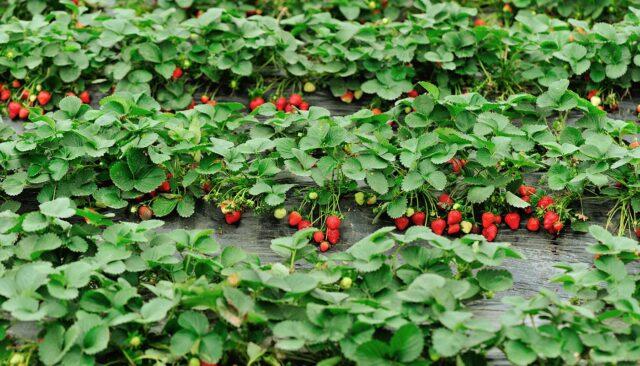
Charlotte strawberries can be grown outdoors in regions with long summers
Resistance to diseases and pests
In general, Charlotte strawberries have fairly good resistance to major diseases and pests. However, in cool, rainy summers, as well as due to improper care, bushes can suffer from the following diseases: gray rot, brown spot, powdery mildew.
For prevention, Charlotte strawberry bushes are treated before flowering begins. For this, proven fungicides are used: Bordeaux mixture, Maxim, Fitosporin, HOM, Fundazol and others.
It is also necessary to remove all affected parts and promptly apply fertilizers containing potassium and superphosphates.
An invasion of pests is also possible. Strawberry mites, aphids, and weevils pose a threat to the crop.
They are fought with folk remedies: a decoction of potato tops, marigold flowers, an infusion of mustard powder, and garlic cloves.In case of mass damage, they resort to insecticides: “Biotlin”, “Fitoverm”, “Match”, “Eforia”, “Aktara” and others.
Advantages and disadvantages of the variety
The yield of Charlotte strawberries is low, so they are not suitable for commercial cultivation. At the same time, summer residents value this crop for its very sweet and aromatic berries, which are superior to many domestic varieties. Culture has other benefits as well.
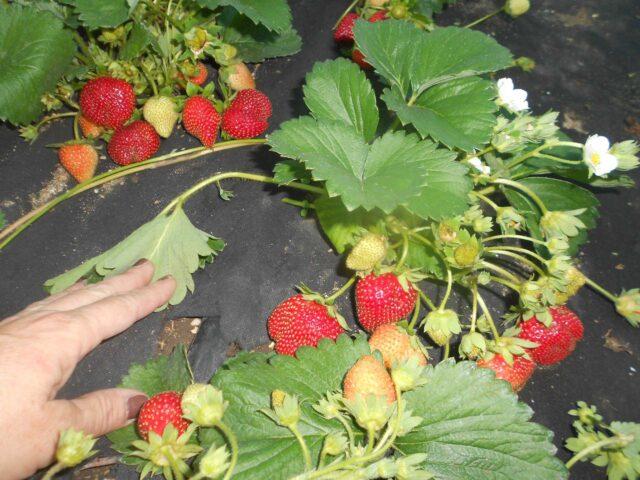
Strawberries Charlotte gives the first harvest in June
Pros:
- very tasty and aromatic berries;
- medium and large, approximately identical fruits;
- long fruiting until September;
- possibility of year-round cultivation;
- low maintenance requirements;
- satisfactory winter hardiness;
- good resistance to common diseases and pests.
Minuses:
- the yield is low and depends on the weather;
- drought resistance is average;
- transportability and keeping quality are low.
Comparison of Charlotte and San Andreas strawberries
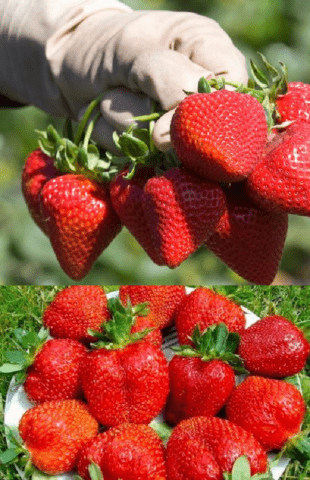
To clearly see the advantages and disadvantages, Charlotte strawberries (in the bottom photo) are sometimes compared with other
If we draw an analogy with the famous San Andreas variety, we can find several similarities:
- compact bushes no more than 30 cm in diameter and height;
- both varieties are remontant;
- a small number of mustaches;
- early ripening;
- extended fruiting until the end of September;
- good resistance to major diseases;
- glossy skin.
The most characteristic differences are presented in the table.
Characteristic | Strawberry variety | |
Charlotte | San Andreas | |
Productivity | 500 g – 1 kg | More than 1 kg |
Mass of berries | 15–20 g | 30–50 g |
Taste | Very sweet | Sweet, sour |
Consistency | Tender | More dense |
Achenes | Not recessed | Depressed |
Keeping quality and transportability | Average | good |
Reproduction methods
Charlotte strawberries can be propagated in any traditional way:
- mustache;
- dividing the bush.
Bushes produce few whiskers, but they can still be used for propagation. To do this, in May or early June they are cut and planted in fertile, light and moist soil at a shallow depth (up to 4 cm). The mustache takes root well in the first season.
Charlotte strawberry bushes begin to be divided at the end of summer. Plants at the age of three years should be dug up and placed in jars with settled water. Then carefully untangle the roots and separate them. Plant in fertile soil, mulch for the winter and cover with agrofibre.
Planting and care
Charlotte strawberries can be planted in spring (early May) or fall (late September). It is advisable that the day is not hot and cloudy. The place should be dry (not lowland) and completely open, illuminated. It is advisable that the area is not blown by strong winds.
The soil is prepared several months in advance - it is dug up and a bucket of compost or humus is added per 1-2 m2. Loams are suitable for Charlotte strawberries. If the soil is heavy, add 1 kg of sand or sawdust to the same area.
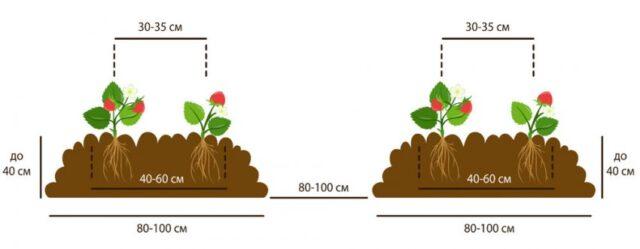
The Charlotte strawberry planting scheme is standard - the bushes are planted in a checkerboard pattern.
The distance between neighboring specimens is 30–35 cm (they are compact and do not grow much). It is enough to leave 80–100 cm between the rows. The mound on the bed can be made 30–40 cm high.
To grow healthy and productive specimens of Charlotte strawberries, as in the description of the variety and in the photo, gardeners in their reviews recommend adhering to several rules:
- Water regularly, especially during drought - 1 liter per 2 bushes. The water should be warm and settled.
- Charlotte does not need frequent fertilizers - in April they give urea or ammonium nitrate (15–20 g per 1 m2), during flowering and fruiting - azofoska (20–30 g per 1 m2) or organic matter (litter 1:20 or mullein 1:10). In autumn, you can water it with an infusion of wood ash (200 g per 10 l).
- Loosening and weeding are carried out periodically (as necessary). To make work easier, it is better to mulch the plantings with straw, sawdust, pine needles or other mulch. You can try growing Charlotte strawberries under agrofibre.
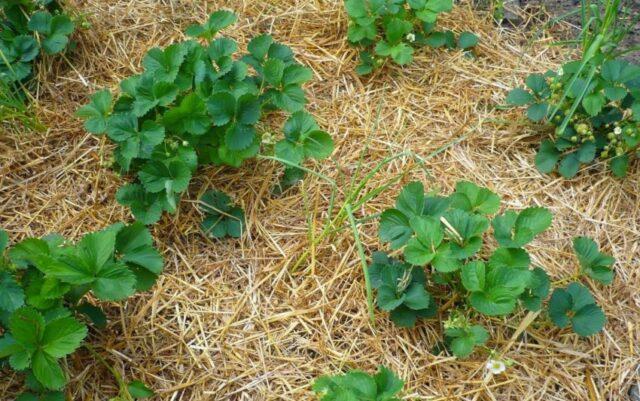
Mulching strawberries makes caring for them much easier.
Preparing for winter
Since Charlotte strawberries were bred abroad, they do not have the same good winter hardiness as many domestic varieties. Therefore, special attention should be paid to shelter for the winter. When the first frost occurs (temperature is about 0 or slightly lower), change the mulch and lay a new layer 5–10 cm high. Place the frame and stretch the agrofibre. In early spring, the shelter is removed, but not all at once, but gradually.
Conclusion
Charlotte strawberries are not very productive, but they produce very tasty berries with a pleasant strawberry aroma. Its fruits are especially good fresh. The harvest can also be used for preserves, jams, fruit drinks and other homemade preparations.
Reviews from gardeners about Charlotte strawberries
